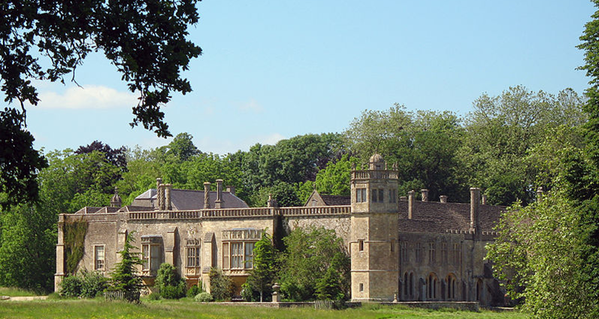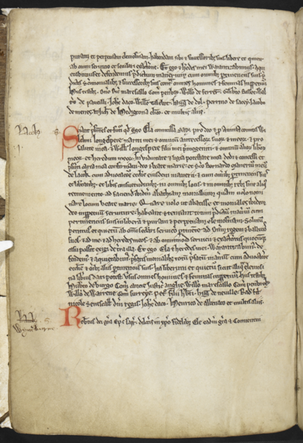 Lacock Abbey established by Ela in 1229 CE, buried in the
Abbey © Neosnaps CC BY-SA 2.0.
Lacock Abbey established by Ela in 1229 CE, buried in the
Abbey © Neosnaps CC BY-SA 2.0.
- dEla, Countess of Salisbury, 1191—1261
Only child and daughter of William FitzPatrick, wife to William Longespée , Earl of Salisbury. After her father’s death nine year old heiress Ela became a royal ward, her lands taken into the king’s possession and she mysteriously disappeared. According to the mid 14th century Book of Lacock Ela was removed from the legal wardship of the King and from his prerogative of bestowing her in marriage, “When Ela was deprived of both her father and mother she was secretly taken into Normandy by her relations and there brought up in close and secret custody”. It appears since her mother was still alive and her family held estates in Normandy and Champaign she or her family were the relations that abducted Ela. Whether their motive was for her safety or to control her assets it cannot be determined yet the story continues. William Talbot, an English knight decided to search for Ela dressing as a pilgrim, wandering Normandy for two years. When he found Lady Ela he exchanged his dress to that of a Troubadour entering the Court and eventually managing to take her back to England where he presented her to King Richard who arranged her marriage to William Longspee, Richard’s illegitimate half-brother. William Talbot continued as a faithful retainer of the House of Salisbury, witnessing several of the Earl’s charters.
|
Upon their marriage Longespée became Earl of Salisbury, taking his father-in-law’s title and that of Sheriff of Wiltshire. Together Ela and Longespée laid foundation stones for Salisbury Cathedral where William would be buried a few years later. Longespée was one of the few who remained loyal to John and was one of the leaders of the king’s army until 1216 when Louis of France and his forces invaded England and Longespée joined other barons in their support of Louis. After the Battle of Lincoln and John’s death he joined other barons in support of Henry III. Holding an influential place in government during the king’s minority Longespée fought in Gascony to help secure the remaining part of the England’s continental possessions. In 1225, his ship was nearly lost in a storm spending several months in refuge at a monastery on the French island of Re.
|
Rumors of Longespée being lost at sea promoted a knight Reimund to approach Ela to become his wife but she refused believing that her husband was still alive. Longespée finally arrived back in England allegedly poisoned by Hubert de Burgh, dying several days later. (His tomb was opened in 1791 and a well-preserved rat carrying traces of arsenic was found inside his skull.) Following her husband’s death Ela never remarried holding the post of Sheriff of Wiltshire in 1227-8 and 1231-7 and appeared at the exchequer in person at Michaelmas to render accounts.
In 1232, Ela 'founded' two convents in one day — Lacock in Wiltshire in the morning and the Charterhouse of Hinton in Somerset, originally established by her husband at Hatherop in Gloucestershire, in the afternoon. About 1238 she entered the nunnery of the Augustinian order and eventually was the Abbess of Lacock until 1257. She obtained many rights for the abbey and village of Lacock including a charter from the Henry III granting the right to hold a fair for St. Thomas of Canterbury, a grant for a Tuesday market, authorization for the nuns to hold a fair on the vigil and feast of St. Peter and Paul including the 6 days following, and a charter giving the abbess of Lacock the privilege of taking a cart round the forest of Melksham to collect dead wood for fuel. Ela has been described as having been "one of the two towering female figures of the mid-13th century.”
In 1232, Ela 'founded' two convents in one day — Lacock in Wiltshire in the morning and the Charterhouse of Hinton in Somerset, originally established by her husband at Hatherop in Gloucestershire, in the afternoon. About 1238 she entered the nunnery of the Augustinian order and eventually was the Abbess of Lacock until 1257. She obtained many rights for the abbey and village of Lacock including a charter from the Henry III granting the right to hold a fair for St. Thomas of Canterbury, a grant for a Tuesday market, authorization for the nuns to hold a fair on the vigil and feast of St. Peter and Paul including the 6 days following, and a charter giving the abbess of Lacock the privilege of taking a cart round the forest of Melksham to collect dead wood for fuel. Ela has been described as having been "one of the two towering female figures of the mid-13th century.”
References and Further Reading
- “Ela .” Foundations for Medieval Genealogy. ENGLAND, EARLS CREATED 1138-1143, Chapter 11. Introduction. Salisbury. Web. 08 August 2016. //fmg.ac/Projects/MedLands/ENGLISH%20NOBILITY%20MEDIEVAL1.htm.
- "Houses of Augustinian canonesses: Abbey of Lacock." A History of the County of Wiltshire. Volume 3. Eds. R B Pugh, and Elizabeth Crittall.
- London: Victoria County History, 1956. 303-316. British History Online. Web. 27 December 2016. //www.british-history.ac.uk/vch/wilts/vol3/pp303-316.
- Koman, Alan J. A Who’s Who of Your Ancestral Saints. Genealogical Publishing Co., 2010.
- Labarge, Margaret Wade. A Small Sound of the Trumpet, Women in Medieval Life. Beacon Press, 1986.
- Richardson, Douglas. Royal Ancestry: A Study in Colonial and Medieval Families. vol. 3 pp 599.5. 2013.
- “The Life Of Ela, Countess of Salisbury “ Wiltshire & Swindon History Centre. posted in Archives. //www.wshc.eu/blog/item/the-life-of-ela-countess-of-salisbury.html.
- Wilkinson, Louise J. Women in Thirteenth-Century Lincolnshire. Royal Historical Society, 2015.
- William Longespée. //www.englishmonarchs.co.uk/plantagenet_78.html
